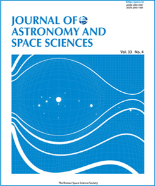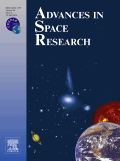
Space Science and Technology-Kosmicna Nauka i Tehnologia
metrics 2024
Fostering collaboration in aerospace engineering and planetary science.
Introduction
Space Science and Technology-Kosmicna Nauka i Tehnologia is an esteemed journal dedicated to advancing knowledge in the fields of Aerospace Engineering and Space and Planetary Science. Published by the well-regarded PUBLISHING HOUSE AKADEMPERIODYKA in Ukraine, this journal serves as a vital platform for researchers, professionals, and students to share groundbreaking findings and innovative technologies related to space exploration and engineering techniques. Since its establishment in 2019, Space Science and Technology has contributed significantly to the academic discourse in its category, currently holding a Q4 quartile ranking in both Aerospace Engineering and Space and Planetary Science as of 2023. Although it does not offer open-access publication, its listed ISSN (1561-8889) and E-ISSN (2518-1459) ensure wide accessibility to its published content. As the journal continues its journey from 2019 to 2024, it strives to enhance its impact and H-index while fostering collaboration and knowledge dissemination across the global space science community.
Metrics 2024
 0.15
0.15 0.60
0.60 0.40
0.40 6
6Metrics History
Rank 2024
Scopus
IF (Web Of Science)
JCI (Web Of Science)
Quartile History
Similar Journals

COSMIC RESEARCH
Illuminating the Mysteries of the CosmosCOSMIC RESEARCH is a prestigious academic journal dedicated to advancing the field of space science, particularly within the domains of aerospace engineering, astronomy, and planetary science. Published by MAIK NAUKA/INTERPERIODICA/SPRINGER, this journal has been a significant contributor to the scholarly discourse since its inception in 1968, with converged years showing robust publication activity until 2024. With a Q4 category ranking in various disciplines, including aerospace engineering, astronomy, and space science, the journal serves as a platform for disseminating innovative research and comprehensive reviews. Although not currently offering open access, COSMIC RESEARCH is renowned for its rigorous peer-review process, ensuring that only high-quality research is shared with the academic community. The journal's ISSN is 0010-9525 and its E-ISSN is 1608-3075. Researchers, professionals, and students alike can benefit from the insights and findings presented in this journal, making it an essential resource for anyone involved in the exploration of cosmic phenomena.

Chinese Space Science and Technology
Transforming Ideas into Space SolutionsChinese Space Science and Technology is a pivotal journal dedicated to advancing the field of space engineering and technology, published by the esteemed Chinese Academy of Space Technology. With an ISSN of 1000-758X, this publication serves as a significant platform for cutting-edge research from China and around the globe, spanning vital intersections of Aerospace Engineering, Electrical and Electronic Engineering, and Materials Science. As evidenced by its Q3 ranking in 2023 across these categories, the journal consistently showcases innovative studies that contribute to the development of space technology, thereby impacting both theoretical frameworks and practical applications in the industry. Researchers and professionals will find valuable insights within its pages, while students can enrich their educational journey through its wealth of knowledge. Though primarily published in print, the journal continues to foster collaboration and engagement among the academic community, offering a glimpse into the future of space exploration and technological advancements through its relevant and timely content.

SOLAR SYSTEM RESEARCH
Exploring the Depths of Our Cosmic NeighborhoodSOLAR SYSTEM RESEARCH, published by Pleides Publishing Inc, offers a comprehensive platform for the exploration and dissemination of scientific knowledge in the fields of Astronomy, Astrophysics, and Space and Planetary Science. With its origins tracing back to 1969, this journal provides a vital resource for researchers and professionals seeking to deepen their understanding of the solar system's complexities, including planetary formation, extraterrestrial geology, and the dynamics of celestial bodies. Although categorized in the Q4 quartile for both relevant disciplines, SOLAR SYSTEM RESEARCH remains committed to publishing high-quality research that contributes to advancing contemporary scientific discourse. Dedicated to fostering collaboration and innovation, the journal is indexed in Scopus and adheres to rigorous academic standards, making it an essential resource for students and professionals alike pursuing the latest developments in solar system studies.

Artificial Satellites-Journal of Planetary Geodesy
Pioneering Research at the Intersection of Satellites and Planetary ScienceArtificial Satellites-Journal of Planetary Geodesy is a pivotal academic journal dedicated to the field of planetary geodesy, focusing on the intersection of satellite technology and planetary sciences. Published by SCIENDO, this journal, with an ISSN of 0208-841X and an E-ISSN of 2083-6104, offers comprehensive insights into current research developments through peer-reviewed articles. Operating under an open-access model, the journal is accessible to a wide audience, fostering a collaborative environment among researchers and practitioners worldwide. Established in 2009, it has emerged as a significant resource, ranking in the Q4 category for Space and Planetary Science and recognized in the Scopus database, placing it within the 12th percentile among earth and planetary sciences journals. The journal's objective is to advance knowledge in the application of satellite technology to planetary studies, making it an essential platform for innovative research, methodological advancements, and interdisciplinary dialogues for professionals, researchers, and students in the field.

Journal of Astronomy and Space Sciences
Illuminating the Universe Through Rigorous Research.The Journal of Astronomy and Space Sciences, published by the Korean Space Science Society, is a premier open-access platform dedicated to advancing the fields of astronomy, astrophysics, and space sciences. Established in 1984, the journal has been instrumental in disseminating high-quality research findings, fostering collaboration among scientists globally, and providing insights into the dynamics of our universe. With an ISSN of 2093-5587 and an E-ISSN of 2093-1409, the journal has gained notable recognition, currently ranking in the Q3 quartile in Earth and Planetary Sciences and Physics and Astronomy as of 2023. Although the journal's H-Index is currently unspecified, its commitment to rigorous peer-review processes and open-access availability ensures that groundbreaking research is accessible to a wide audience. Based in Seoul, South Korea, the journal is poised to continue supporting innovative research through 2024 and beyond. Researchers, professionals, and students alike will find valuable resources and opportunities within its pages, further establishing this journal as a crucial resource in the exploration of the cosmos.

EARTH PLANETS AND SPACE
Bridging Earth Sciences and Cosmic PhenomenaEARTH PLANETS AND SPACE, published by Springer and based in Switzerland, is a distinguished journal that plays a pivotal role in advancing the fields of Earth and planetary sciences. With an impactful presence in both geology (Q1) and space and planetary science (Q2), this journal is increasingly recognized for its contributions to understanding complex geoscientific processes and extraterrestrial phenomena. The journal has been a vital resource for researchers since its inception in 1996 and is anticipated to continue this legacy until at least 2024. It ranks impressively within the Scopus database, holding the 53rd position out of 321 in Earth and Planetary Sciences for Geology and the 30th position out of 104 for Space and Planetary Science, reflecting a robust percentile standing of 83 and 71, respectively. With open access options available, EARTH PLANETS AND SPACE makes cutting-edge research more accessible to a global audience, fostering collaboration and innovation. This journal is essential for anyone seeking to deepen their knowledge or stay current with trends in Earth sciences and planetary exploration.

Solar-Terrestrial Physics
Empowering Research in Atmospheric, Geophysical, and Planetary SciencesSolar-Terrestrial Physics is a pivotal Open Access journal dedicated to advancing the understanding of the complex interactions between solar and terrestrial phenomena. Published by the NAUCNO-IZDATELSKIJ CENTR INFRAM in the Russian Federation, this journal has established itself as a significant platform for disseminating cutting-edge research within the fields of Atmospheric Science, Geophysics, and Space and Planetary Science. Since its transition to Open Access in 2017, it has bolstered academic accessibility, fostering the dissemination of knowledge to a global audience. With its current category quartiles ranking Q4 in Atmospheric Science and Q3 in both Geophysics and Space and Planetary Science, it actively contributes to the scholarly dialogue essential for innovation and research development. Researchers and practitioners can submit their work with ease, knowing their contributions will reach an engaged audience. The journal is an essential resource for those focused on exploring the dynamics of solar-terrestrial relationships, critical for understanding broader planetary systems.

GEOMAGNETISM AND AERONOMY
Exploring Earth's Magnetic Mysteries and Atmospheric WondersGEOMAGNETISM AND AERONOMY, published by MAIK NAUKA/INTERPERIODICA/SPRINGER, is a prominent journal dedicated to advancing the fields of geophysics and planetary science. With ISSN 0016-7932 and E-ISSN 1555-645X, this journal serves as a critical platform for researchers to disseminate their findings on geomagnetic phenomena and aeronomical studies, fostering a deeper understanding of Earth's magnetic field dynamics and atmospheric interactions. Spanning publishing years from 1996 to 2024, it is categorized in the Q3 quartile for geophysics and Q4 for space and planetary science, reflecting its positioning within the academic landscape. Although not open access, readers and researchers can access valuable insights into geomagnetic and atmospheric research, contributing to ongoing discourse in these vital scientific domains. With a focus on innovative research, GEOMAGNETISM AND AERONOMY remains an essential resource for professionals and students aiming to deepen their expertise in Earth and planetary sciences.

Space: Science & Technology
Innovative Insights into Aerospace EngineeringSpace: Science & Technology is a premier, open-access journal published by the American Association for the Advancement of Science, dedicated to advancing knowledge in the rapidly evolving fields of aerospace engineering and space sciences. Since its inception in 2021, the journal has rapidly established itself as a vital resource, achieving an impressive Q1 ranking in Aerospace Engineering and Q2 ranking in Space and Planetary Science as of 2023. With a Scopus rank placing it 45th out of 153 in Aerospace Engineering and 47th out of 104 in Space and Planetary Science, it serves as a critical platform for researchers, engineers, and students alike to disseminate their findings and engage with the latest developments in their field. The journal encourages innovative research articles, technical notes, and reviews that push the boundaries of what's possible in space exploration and technology. With its commitment to open access since 2021, Space: Science & Technology ensures that pioneering research is readily available to a global audience, promoting collaboration and knowledge sharing in an increasingly interconnected scientific community.

ADVANCES IN SPACE RESEARCH
Charting New Territories in Planetary Sciences.ADVANCES IN SPACE RESEARCH, published by Elsevier Science Ltd, is a leading journal in the fields of Aerospace Engineering, Astronomy and Astrophysics, Atmospheric Science, and more. Since its inception in 1981, this journal has dedicated itself to the dissemination of high-quality research contributing to the understanding of space and planetary sciences through a multidisciplinary lens. With an impressive impact factor reflected in its positioning within the Q1 and Q2 quartiles across various categories, it serves as an essential resource for researchers and professionals alike. The journal's rigorous peer review process ensures that only the most relevant and groundbreaking studies are published, making it a cornerstone for those navigating the complexities of space research. The journal is accessible by subscription, inviting a global readership to engage with trailblazing research that influences future advancements and fosters collaborations across the scientific community. With a reputation for excellence, ADVANCES IN SPACE RESEARCH remains committed to pushing the boundaries of knowledge in the ever-evolving field of space exploration.